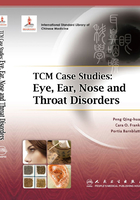
上QQ阅读APP看书,第一时间看更新
CASE SCENARIOS
The following cases present variations of this condition. Afer familiarizing yourself with the possible common patern presentations and appropriate formulas for treatment, use the following exercises to test your overall understanding of the condition.
1. Male, age 26. The patient suffered from redness, dryness and pain in the right eye, purplish-red bulging nodules in the sclera, eye pain, sensitive to the touch. Accompanying symptoms included a dry mouth and sore throat, yellow and reddish urine, hard stools, a red tongue with a thin yellow coating and a rapid pulse.
Select the most appropriate formula:
A. Sāng Jú Yĭn (Mulberry Leaf and Chrysanthemum Beverage)
B. Xiè Bái Săn (White-Draining Powder)
C. Yăng Yīn Qīn Fèi Tāng (Yin-Nourishing and Lung-Clearing Decoction)
D. Lóng Dăn Xiè Gān Tāng (Gentian Liver-Draining Decoction)
E. Sàn Fēng Chú Shī Huó Xuè Tāng (Wind-Dissipating, Dampness-Eliminating and Blood-Moving Decoction)
2. Female, age 38. The patient suffered from frequent reoccurrence of redness and pain in the lef eye with difcult recovery. There were purplish bulging nodules in the sclera, along with a dry mouth and throat, a red tongue with a reduced coating and a thin, rapid pulse.
Select the most appropriate formula:
A. Xiè Bái Săn (White-Draining Powder)
B. Yăng Yīn Qīn Fèi Tāng (Yin-Nourishing and Lung-Clearing Decoction)
C. Qīng Zào Jiù Fèi Tāng (Dryness-Clearing Lung-Rescuing Decoction)
D. Zhī Băi Dì Huáng Wán (Anemarrhena, Phellodendron and Rehmannia Pill)
E. Shā Shēn Mài Dōng Tāng (Adenophora and Ophiopogon Decoction)
3. Female, age 51. The patient suffered from a stufy and painful sensation in the right eye, photophobia, tearing and purplish-red, bulging nodules in the sclera. There was also joint pain, a red tongue with a yellow, greasy coating and a soggy, rapid pulse.
Select the most appropriate formula:
A . Xiè Bái Săn (White-Draining Powder)
B . Huán Yīn Jiù Kŭ Tāng (Yin-Returning Bitterness-Relieving Decoction)
C . Sàn Fēng Chú Shī Huó Xuè Tāng (Wind-Dissipating, Dampness-Eliminating and Blood-Moving Decoction)
D . Sān Rén Tāng (Three Kernels Decoction)
E . Yăng Yīn Qīng Fèi Tāng (Yin-Nourishing and Lung-Clearing Decoction)
4. Female, age 43. The patient suffered from excruciating pain in the left eye, photophobia, tearing, purplish red bulging nodules in the sclera, and red, purple, swelling collaterals in the surrounding area. This was accompanied by a biter taste in the mouth, a dry throat, reddish urine, constipation, a red tongue with yellow coating, and a rapid strong pulse.
Select the most appropriate formula:
A. Huáng Lián Jiĕ Dú Tāng (Coptis Toxin-Resolving Decoction)
B. Lóng Dăn Xiè Gān Tāng (Gentian Liver-Draining Decoction)
C. Dăo Chì Săn (Red-Guiding Powder)
D. Huán Yīn Jiù Kŭ Tāng (Yin-Returning Bitterness-Relieving Decoction)
E. Yín Qiào Săn (Lonicera and Forsythia Powder)
Answers
1. B
2. B
3. C
4. D
Additional Commentary
Of the four cases presented here, the frst three are treated with formulas that are familiar to most readers. The fourth scenario is worth reviewing, as the physician uses an unusual formula unfamiliar to most Western practitioners. Huán Yín Jiù Kŭ Tāng (Yin-Returning Biterness-Relieving Decoction) was frst recorded in the Secrets fromthe Orchid Chamber ( Lán Shì Mì Cáng, 兰室秘藏) writen by Li Dong-yuan.
Formula: Huán Yīn Jiù Kŭ Tāng (Yin-Returning Biterness-Relieving Decoction)
[还阴救苦汤]

[Method]
“For each liăng of these medicinals, add 2 Chinese cups of water, boil down to 1 cup. Strain, and take warm, afer eating. If there is pain, add more of the biter cold medicinals and adjust the quantity of the medicinals that go to the relevant channels. If the eyes are cloudy, double the dose of zhī mŭ and huáng băi. Treats sudden onset of redness, swelling, or protrusion, and insuferable pain of the eyes.”
The formula is large and unwieldy, and there are references to several other formulas that clear heat and infammation easily identifed within the primary formula These include Yín Qiào Săn (Lonicera and Forsythia Powder), Èr Miào Săn (Two Mysterious Powder), Huáng Lián Jiĕ Dú Tāng (Coptis Toxin-Resolving Decoction), Qiāng Huó Shèng Shī Tāng (Notopterygium Dampness-Drying Decoction), Zhī Băi DìHuáng Wán (Anemarrhena, Phellodendron and Rehmannia Pill) and Lóng Dăn Xiè GānTāng (Gentian Liver-Draining Decoction).
The ingredients can be grouped in the following way:
Jié gĕng and lián qiào beneft the throat and reduce nodulation.
Qiāng huó, shēng má and chái hú enter the taiyang, yangming and shaoyang channels respectively.
Huáng băi, huáng qín, huáng lián and lóng dăn are all biter and cold. They clear heat and dampness from all three burners.
Huáng băi and zhī mŭ are paired in several formulas to nourish the yin and clear empty fre.
Huáng băi and cāng zhú create the formula Èr Miào Săn. The actions are to clear heat and dry dampness from the lower jiao.
Qiāng huó, fáng fēng and găo bĕn expel wind and dampness to alleviate pain in the head. They are featured together in the formula Qiāng Huó Shèng Shī Tāng.
Xì xīn is acrid and hot. It dispels wind and cold, and stops pain. When paired with hóng huā and dāng guī shēn, they harmonize the blood and alleviate pain. Because the majority of the formula is biter, drying and cold, dāng guī and shēng dì protect the yin and blood. This pair is used similarly in the formula Lóng Dăn Xiè Gān Tāng.
The fnal medicinal in the formula is chuān xiōng. The dose is signifcantly higher than any other medicinal, underscoring its importance. Its function of expelling wind, regulating the blood and stopping pain makes a strong case to designate this medicinal the formula’s monarch. For the treatment of head pain, chuān xiōng is supported by xì xīn, qiāng huó, fáng fēng and găo bĕn. To harmonize the blood, it is supported by hóng huā and dāng guī.
In summary, effective treatment of acute scleritis requires a strategy that encompasses the entire body. Treatment should be staged to control the acute fare up frst and then resolve the patient’s constitutional imbalances to prevent recurrence.